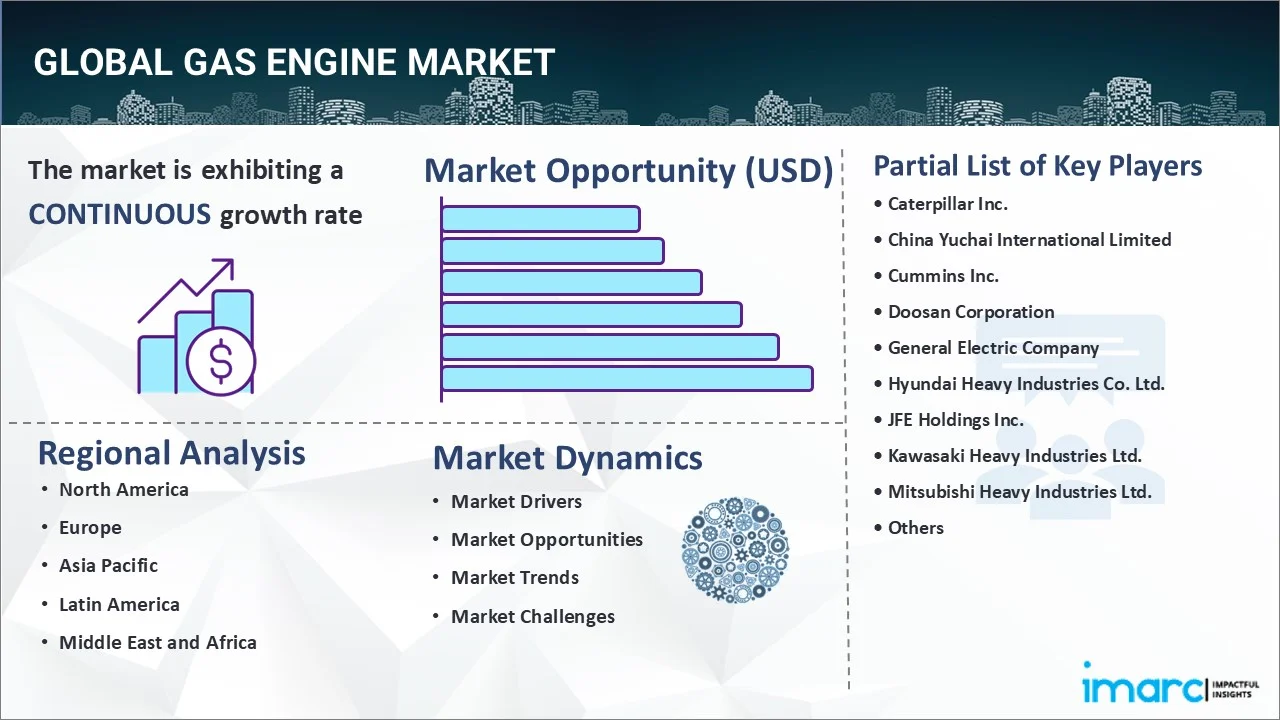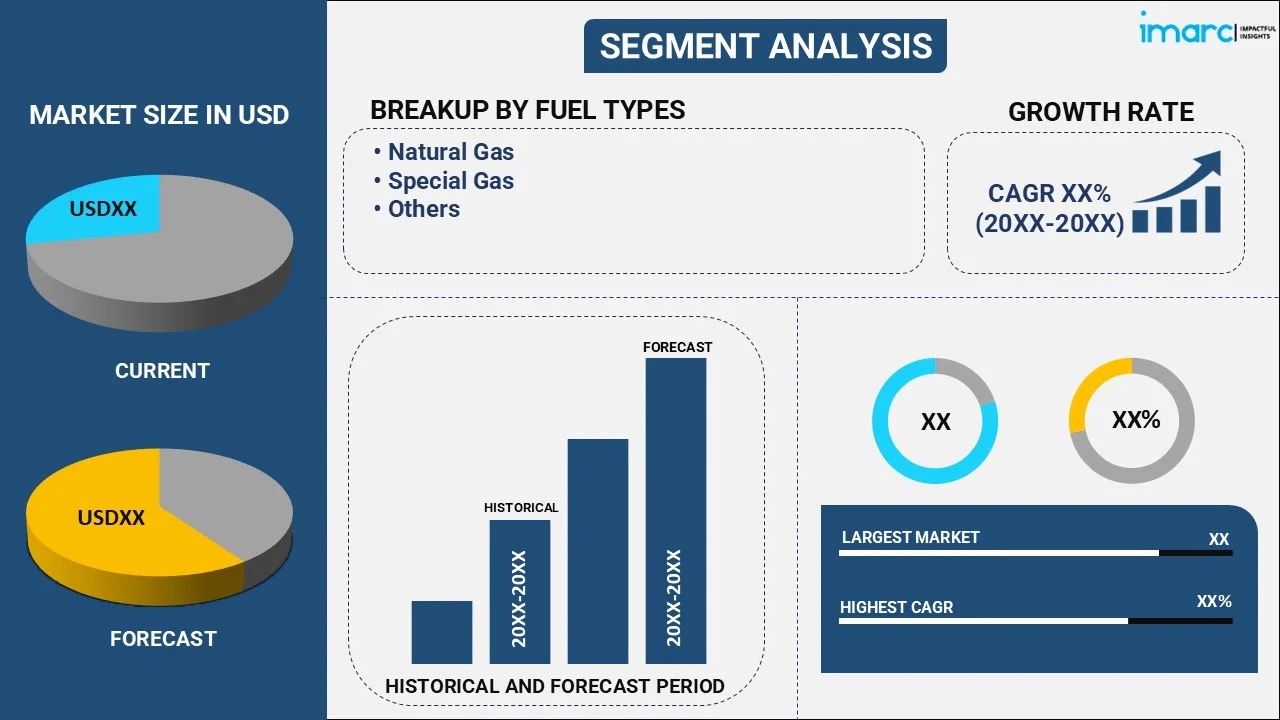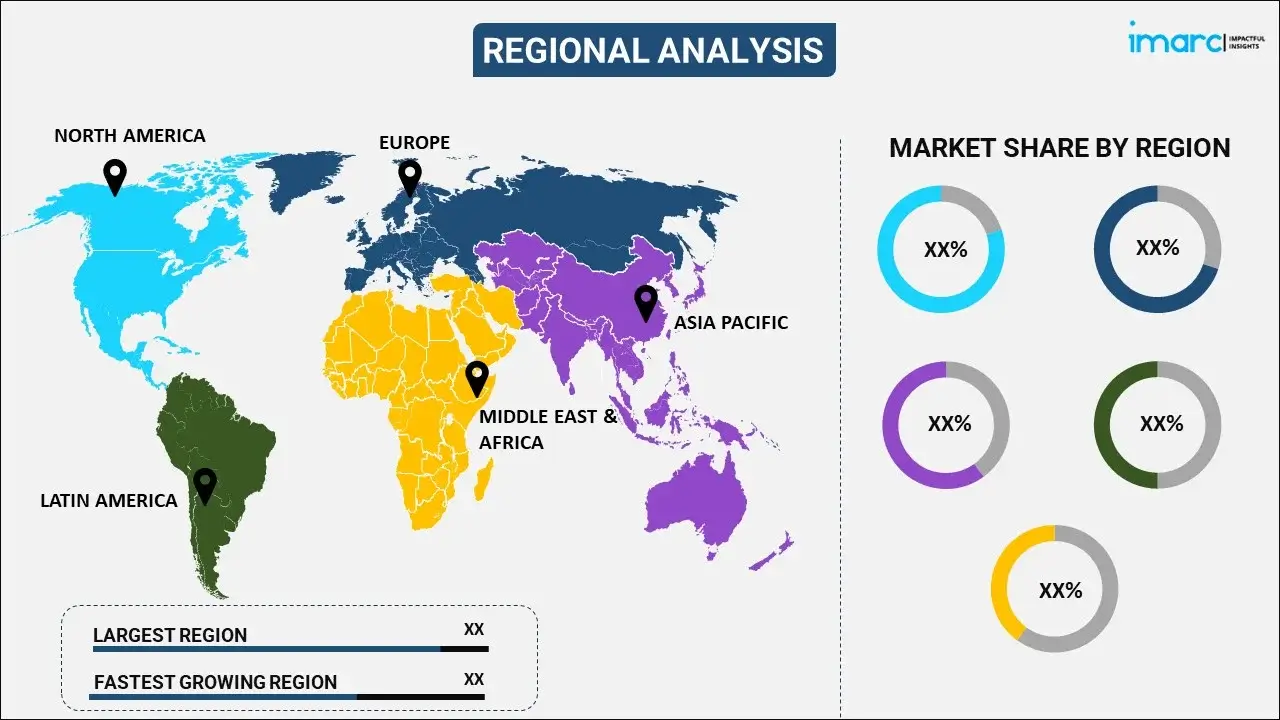
Gas Engine Market Report by Fuel Type (Natural Gas, Special Gas, and Others), Power Output (0.5-1 MW, 1-2 MW, 2-5 MW, 5-10 MW, 10-20 MW), Application (Mechanical Drive, Power Generation, Cogeneration, and Others), Industry Vertical (Utilities, Manufacturing, Oil and Gas, Mining, and Others), and Region 2025-2033
Gas Engine Market Size:
The global gas engine market size reached USD 5.8 Billion in 2024. Looking forward, IMARC Group expects the market to reach USD 8.1 Billion by 2033, exhibiting a growth rate (CAGR) of 3.9% during 2025-2033. The increasing use of hybrid systems that combine gas engines with renewable sources, rising need for uninterrupted power supply, and the growing number of data centers are some of the major factors propelling the market.
|
Report Attribute
|
Key Statistics
|
|---|---|
|
Base Year
|
2024 |
|
Forecast Years
|
2025-2033
|
|
Historical Years
|
2019-2024
|
| Market Size in 2024 | USD 5.8 Billion |
| Market Forecast in 2033 | USD 8.1 Billion |
| Market Growth Rate (2025-2033) | 3.9% |
Gas Engine Market Analysis:
- Major Market Drivers: Increasing demand for clean energy sources, the abundant availability of natural gas, growing adoption of gas engines in industrial applications and power generation, rapid technological advancements in gas engine efficiency, and stringent environmental regulations are the major drivers for gas engine market.
- Key Market Trends: Key trends in the gas engine market include a shift towards high-efficiency, low-emission engines, increasing use of biogas and hydrogen fuels, and integration of IoT technology for performance monitoring and predictive maintenance. There is also a growing focus on hybrid power systems combining gas engines with renewable energy sources.
- Geographical Trends: North America is leading the gas engine market due to the presence of advanced gas infrastructure, significant investments in energy-efficient power generation, abundant natural gas reserves, and the region’s commitment to renewable energy integration.
- Competitive Landscape: Some of the major market players in the Gas Engine industry include Caterpillar Inc., China Yuchai International Limited, Cummins Inc., Doosan Corporation, General Electric Company, Hyundai Heavy Industries Co. Ltd., JFE Holdings Inc., Kawasaki Heavy Industries Ltd., Mitsubishi Heavy Industries Ltd., Rolls-Royce plc, Siemens AG, Volkswagen AG, and Wärtsilä Oyj Abp, among many others.
- Challenges and Opportunities: Challenges in the gas engine market include stringent environmental regulations and competition from alternative renewable technologies. Opportunities arise from the increasing demand for sustainable energy solutions and the potential for gas engines to integrate with hybrid systems, offering cleaner, more efficient energy production in diverse applications.

Gas Engine Market Trends:
Rapid Industrialization
One of the primary factors driving the demand for gas engines is the rapid pace of industrialization worldwide. As developing countries seek to modernize, their energy requirements are surging. Gas engines, known for their reliability and efficiency, are often the go-to solution for power generation in industrial settings. They offer a robust and flexible way to meet fluctuating energy needs. Moreover, gas engines can run on a variety of fuels, including natural gas, making them a versatile choice for diverse industries, such as manufacturing, petrochemicals, and textiles. According to a report by the US Energy Information Administration, the total electricity consumption in the United States in 2022 was about 4.07 trillion kWh, an increase of 2.6% compared to the previous year. Furthermore, it is forecasted that the energy consumption will experience a 2% increase in 2024 from 2023, with the highest consumption anticipated from the residential sector with a 4% rise.
Rise in Environmental Concerns
With the growing awareness about climate change, there is an increase in the shift towards cleaner energy options. According to IPCC’s Sixth Assessment Report on the Physical Basis of Climate Change, burning fossil fuels add about 11 billion metric tons of carbon to the atmosphere each year. Similarly, another data provided by the 2023 Global Climate Report from NOAA National Centers for Environmental Information, stated that the combined ocean and land temperature increases at an average rate of 0.20 degree Celsius per decade. Moreover, every month of 2023 ranked among the 7 warmest for that month with global temperatures for July, August, and September reaching 1.0 degree Celsius above the long-term average. Gas engines emit fewer greenhouse gases as compared to traditional coal-fired or oil-based power generation systems. This makes them a more environment friendly choice for meeting energy needs. The adoption of strict emission regulations by governments worldwide further pushes industries and power plants toward gas engines, boosting their demand.
Growing Energy Security
Dependence on a single source or type of energy can pose risks to a country’s energy security. Gas engines offer an alternative to diversify the energy mix, which reduces reliance on imported oil or centralized power grids. Natural gas is abundant and can be sourced domestically or regionally, which contributes to energy security and stability. This has led to increased investment in gas engine technologies, thereby further driving demand. According to the Global Energy Monitor, over 748 gigawatts (GW) of natural gas power plants are in pre- and construction phases, costing around US$ 601 billion in capital expenditure. For instance, in November 2022, Wartsila received an order for two 34SG gas engines by the Tamilnadu Petroproducts Limited (TPL) for 15.5 MW captive power plant in Chennai, India.
Gas Engine Market Segmentation:
IMARC Group provides an analysis of the key trends in each segment of the market, along with forecasts at the global, regional, and country levels for 2025-2033. Our report has categorized the market based on fuel type, power output, application, and industry vertical.
Breakup by Fuel Type:

- Natural Gas
- Special Gas
- Others
Natural gas dominates the market
The report has provided a detailed breakup and analysis of the market based on the fuel type. This includes natural gas, special gas, and others. According to the report, natural gas represented the largest segment.
Natural gas is one of the commonly used fuels for gas engines. Composed primarily of methane, it is a naturally occurring fossil fuel that is extracted from underground reserves. Natural gas engines are known for their efficiency and reduced emissions as compared to engines running on gasoline or diesel. According to the Ministry of Petroleum and Natural Gas, as of 2023, India’s share of natural gas in energy basket is 6.7%. The government has set a target to raise the share of natural gas in energy mix to 15% in 2030. Such policy-level initiatives are likely to boost the natural gas sector.
Breakup by Power Output:
- 0.5-1 MW
- 1-2 MW
- 2-5 MW
- 5-10 MW
- 10-20 MW
1-2 MW holds the largest share in the market
A detailed breakup and analysis of the market based on the power output has also been provided in the report. This includes 0.5-1 MW, 1-2 MW, 2-5 MW, 5-10 MW, and 10-20 MW. According to the report, 1-2 MW accounted for the largest market share.
Engines with a power output of 1-2 MW are used in applications that require a moderate amount of power. These are commonly found in medium-sized manufacturing facilities, large commercial buildings, and small-scale power plants. They are versatile and can be used either as the main power source or as a backup.
Breakup by Application:
- Mechanical Drive
- Power Generation
- Cogeneration
- Others
Power generation dominates the market
The report has provided a detailed breakup and analysis of the market based on the application. This includes mechanical drive, power generation, cogeneration, and others. According to the report, power generation represented the largest segment.
One of the most common applications of gas engines is in power generation. These engines are used to generate electricity, either as the main power source or as backup generators for commercial buildings, industrial facilities, and residential areas. For instance, in October 2021, Briggs & Stratton launched Vanguard 400 series engines designed to deliver dependable power for various commercial and industrial equipment. In another example, in April 2021, Northern Tool + Equipment Co., a US-based tool retail company, acquired Jack's Small Engines, a family-owned small engine parts and outdoor power equipment parts company. This acquisition enhances Northern Tool + Equipment Co. 's capabilities in tools, equipment, engines, and maintenance services, consolidating its position in the market.
Breakup by Industry Vertical:
- Utilities
- Manufacturing
- Oil and Gas
- Mining
- Others
Utilities dominate the market
A detailed breakup and analysis of the market based on the industry vertical has also been provided in the report. This includes utilities, manufacturing, oil and gas, mining, and others. According to the report, utilities represented the largest segment.
In the utilities sector, gas engines play a pivotal role in power generation. They are commonly used in both centralized and decentralized energy systems. Smaller engines may serve as backup generators for residential and commercial buildings, while larger engines with outputs in the megawatt range can be employed in utility-scale power plants. Gas engines are valued for their efficiency, lower emissions, and capability to quickly ramp up or down based on energy demand.
Breakup by Region:

- North America
- United States
- Canada
- Asia Pacific
- China
- Japan
- India
- South Korea
- Australia
- Indonesia
- Others
- Europe
- Germany
- France
- United Kingdom
- Italy
- Spain
- Russia
- Others
- Latin America
- Brazil
- Mexico
- Others
- Middle East and Africa
North America exhibits a clear dominance, accounting for the largest gas engine market share
The market research report has also provided a comprehensive analysis of all the major regional markets, which include North America (the United States and Canada); Asia Pacific (China, Japan, India, South Korea, Australia, Indonesia, and others); Europe (Germany, France, the United Kingdom, Italy, Spain, Russia, and others); Latin America (Brazil, Mexico, and others); and the Middle East and Africa. According to the report, North America accounted for the largest market share.
The increasing extraction of shale gas represents one of the primary factors driving the demand for gas engines in the North American region. Moreover, the rising environmental awareness and stricter governmental policies on emissions are driving the demand for cleaner energy solutions like gas engines in the region. Besides this, the growing demand for reliable and efficient power is influencing the market positively. In addition to this, key players are expanding significantly in the region. For instance, Cummins Inc. announced in 2024 that its new 15-liter natural gas engine designed for heavy-duty and on-highway applications could lead to a 5-fold growth in customers for the alternative powertrain. It overcomes complaints about low power and torque and can run on potentially net-zero carbon renewable natural gas (RNG), as stated by its North America region Company Head.
Competitive Landscape:
- The market research report has also provided a comprehensive analysis of the competitive landscape in the market. Detailed profiles of all major companies have also been provided. Some of the major market players in the gas engine industry include Caterpillar Inc., China Yuchai International Limited, Cummins Inc., Doosan Corporation, General Electric Company, Hyundai Heavy Industries Co. Ltd., JFE Holdings Inc., Kawasaki Heavy Industries Ltd., Mitsubishi Heavy Industries Ltd., Rolls-Royce plc, Siemens AG, Volkswagen AG, and Wärtsilä Oyj Abp, among many others.
(Please note that this is only a partial list of the key players, and the complete list is provided in the report.)
- The leading companies are integrating turbochargers that allow for more air to be compressed and mixed with fuel, which leads to more powerful combustion and results in higher power output from a smaller engine size, effectively improving fuel efficiency. They are also equipped with advanced electronic control units (ECUs) that offer precise control over various engine parameters like fuel injection, air-to-fuel ratio, and ignition timing and improve performance, reduce fuel consumption, and enable easier diagnostics and maintenance. Moreover, key players are developing hybrid gas engines that are designed to work in tandem with renewable energy sources, such as solar or wind power. These hybrid systems can switch between power sources as needed, which ensures constant energy supply while reducing the overall carbon footprint. For instance, in February 2021, TMH International, a Switzerland-based railroad equipment manufacturing company, acquired Rolls-Royce's Bergen Engines medium-speed gas and diesel engines business for $163 million.
Gas Engine Market News:
- In April 2023, Clarke Energy received order to deliver 50MW of hydrogen ready INNIO Jenbacher gas engines to VPI's expansion at Immingham energy hub.
- In January 2023, Rolls-Royce announced that it had conducted successful tests of a 12-cylinder gas variant of the mtu Series 4000 L64 engine running on 100% hydrogen fuel. In the tests carried out by the Power Systems business unit, the company stated that the engine showed excellent characteristics in terms of efficiency, performance, emissions, and combustion.
- In October 2023, Jineng (Zhoushan) Gas Power Generation Co. placed an order with GE Vernova for two of its 9HA.02 combined-cycle gas turbines in collaboration with Harbin Electric Corporation.
Gas Engine Market Report Scope:
| Report Features | Details |
|---|---|
| Base Year of the Analysis | 2024 |
| Historical Period | 2019-2024 |
| Forecast Period | 2025-2033 |
| Units | Billion USD |
| Scope of the Report | Exploration of Historical Trends and Market Outlook, Industry Catalysts and Challenges, Segment-Wise Historical and Future Market Assessment:
|
| Fuel Types Covered | Natural Gas, Special Gas, Others |
| Power Outputs Covered | 0.5-1 MW, 1-2 MW, 2-5 MW, 5-10 MW, 10-20 MW |
| Applications Covered | Mechanical Drive, Power Generation, Cogeneration, Others |
| Industry Verticals Covered | Utilities, Manufacturing, Oil and Gas, Mining, Others |
| Regions Covered | North America, Asia Pacific, Europe, Latin America, Middle East and Africa |
| Countries Covered | United States, Canada, China, Japan, India, South Korea, Australia, Indonesia, Germany, France, United Kingdom, Italy, Spain, Russia, Brazil, Mexico |
| Companies Covered | Caterpillar Inc., China Yuchai International Limited, Cummins Inc., Doosan Corporation, General Electric Company, Hyundai Heavy Industries Co. Ltd., JFE Holdings Inc., Kawasaki Heavy Industries Ltd., Mitsubishi Heavy Industries Ltd., Rolls-Royce plc, Siemens AG, Volkswagen AG, Wärtsilä Oyj Abp, etc. |
| Customization Scope | 10% Free Customization |
| Post-Sale Analyst Support | 10-12 Weeks |
| Delivery Format | PDF and Excel through Email (We can also provide the editable version of the report in PPT/Word format on special request) |
Key Benefits for Stakeholders:
- IMARC’s industry report offers a comprehensive quantitative analysis of various market segments, historical and current market trends, market forecasts, and dynamics of the gas engine market from 2019-2033.
- The research report provides the latest information on the market drivers, challenges, and opportunities in the global gas engine market.
- The study maps the leading, as well as the fastest-growing, regional markets. It further enables stakeholders to identify the key country-level markets within each region.
- Porter's five forces analysis assists stakeholders in assessing the impact of new entrants, competitive rivalry, supplier power, buyer power, and the threat of substitution. It helps stakeholders to analyze the level of competition within the gas engine industry and its attractiveness.
- The competitive landscape allows stakeholders to understand their competitive environment and provides insight into the current positions of key players in the market.
Key Questions Answered in This Report
The gas engine market was valued at USD 5.8 Billion in 2024.
IMARC estimates the gas engine market to exhibit a CAGR of 3.9% during 2025-2033.
The increasing demand for cleaner energy solutions, advancements in gas engine efficiency and performance, rising adoption of natural gas as an alternative fuel, government regulations promoting lower emissions, and growth in industries such as power generation and transportation are the primary factors driving the gas engine market.
On a regional level, the market has been classified into North America, Asia Pacific, Europe, Latin America, and Middle East and Africa, wherein North America currently dominates the market.
Some of the major players in the gas engine market include Caterpillar Inc., China Yuchai International Limited, Cummins Inc., Doosan Corporation, General Electric Company, Hyundai Heavy Industries Co. Ltd., JFE Holdings Inc., Kawasaki Heavy Industries Ltd., Mitsubishi Heavy Industries Ltd., Rolls-Royce plc, Siemens AG, Volkswagen AG, and Wärtsilä Oyj Abp, etc.
Need more help?
- Speak to our experienced analysts for insights on the current market scenarios.
- Include additional segments and countries to customize the report as per your requirement.
- Gain an unparalleled competitive advantage in your domain by understanding how to utilize the report and positively impacting your operations and revenue.
- For further assistance, please connect with our analysts.
 Inquire Before Buying
Inquire Before Buying
 Speak to an Analyst
Speak to an Analyst
 Request Brochure
Request Brochure
 Request Customization
Request Customization




.webp)




.webp)












